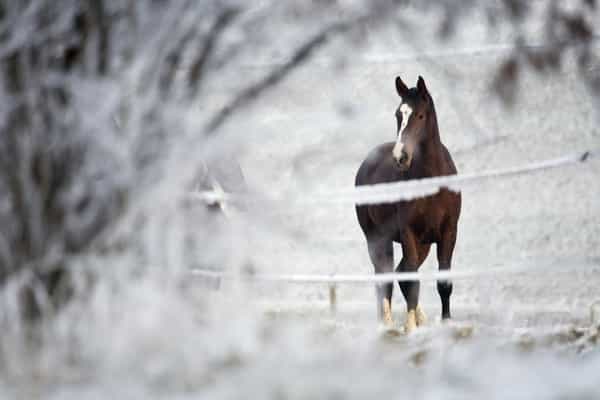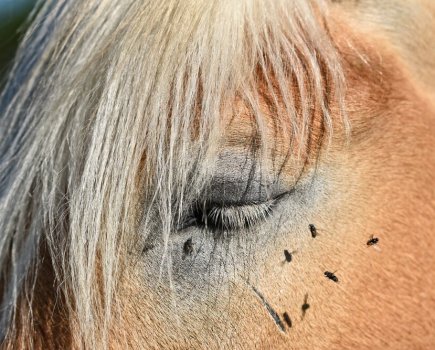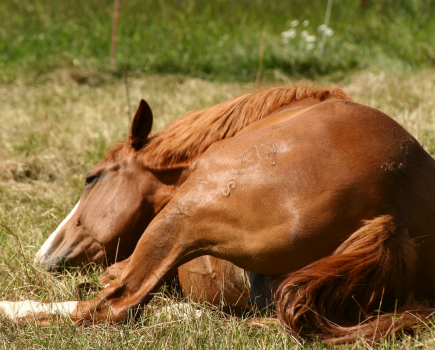It can be a tricky time to own, ride and take care of a horse in winter. There are fewer daylight hours, colder temperatures, icy buckets, lots of mud and more time standing in a stable. While the weather can be unpredictable, it doesn’t have to be stressful to manage your horse through the winter. With some forward planning, you can get the most out of every minute spent on the yard, whether you’re riding or doing stable jobs.
By making a winter management plan, you will feel more confident and organised. The following six tips from equine charity Bransby Horses will help you care for a horse this winter.
1 Provide the right nutrition
Over centuries, horses have evolved to create a digestive process which ferments their food and creates extra heat. Forage, such as hay, produces more heat during the fermentation process than other food.
As tempting as it might seem, it is not advisable to overload horses on hard/concentrate feed during winter if they are not working hard. Doing so can lead to health issues such as colic, obesity and laminitis.
Given this, it is vital animals have access to good amounts of forage in winter. Spreading the hay out across paddocks will reduce the risk of fighting and injury. It is recommended that older horses have a dental check to ensure they have a good grinding surface so that they can cope with forage during winter.
Due to the low nutritional content of grass in the winter, it is also widely recommended to give a vitamin and mineral supplement or a feed balancer.
2 Check your water supply
Water is just as important in the winter as it is during the summer. In fact, horses often drink more water in the winter when they are fed more dried forage, such as hay.
Remember to check troughs each day to ensure they are clean and not frozen. A tennis ball or small football left to float in the water can help to stop water freezing when it’s really cold.
Sometimes, really low temperatures can also cause pipes and taps to freeze, so keep an eye on the forecast and if they do drop, fill up some emergency buckets of water in a tack or feed room to use as back up.
3 Choose the right rugs
Horses and ponies have evolved to fluctuate their weight during the year, enabling them to adapt to the various seasons. During the spring and summer months, many horses and ponies pile on a few extra pounds and store them as fat for the winter.
A horse’s innate ability to fluctuate weight can be affected by unnecessary rug use, which can lead to long-term obesity and other health complications. This is why not all horses or ponies need rugs — even when it’s raining. Key factors such as the breed, age, living conditions, workload and health status should be considered.
Native types such as Shetland and Welsh ponies are adapted to living in colder conditions. They grow thick winter coats which are packed full of natural oils to protect from them from the elements. Excessive grooming can remove these oils, so be mindful not to over groom these naturally hardy breeds.
Warmbloods and Thoroughbreds, who have finer coats, are more likely to struggle to keep warm and would benefit from a rug. Working horses which are clipped need to be rugged, as will older, sick or injured horses. Remove rugs daily and check for signs of rubbing or skin irritation. It is easy to over-rug, though. Learn when your horse really feels cold here.
Pick the right weight rug for the weather conditions and the horse’s needs. Equally, rugs that aren’t made from breathable materials can cause more problems than they solve. Choose your horse’s rug wisely and if in doubt, speak to the manufacturer.
Having somewhere to dry your rugs when they get soaked in the rain and a spare rug to rotate during wetter days is also a good idea.
4 Provide shelter from the weather
Whether your horse is stabled overnight or lives out all year round — each approach has its own merits. Choosing to turn out all year is an option for your horse or pony, as long as suitable shelter and forage are available. Outdoor shelters don’t have to be manmade structures — a group of trees can provide adequate shelter, as can hedges. Just be sure the whole herd can comfortably seek shelter in the paddock without risk of being kicked and/or injured.
If choosing to stable a horse, provide low-dust bedding that is deep enough for the horse to comfortably lie down on. Muck out and air the stable daily to prevent a build-up of ammonia, which can cause respiratory problems.
Stabled horses should be turned out daily to exercise and exert their natural behaviours. Horses who are confined to a stable, without regular turning out, can suffer physical and mental stress, but there are things you can do to help prevent this.
If your fields are too wet to use consider what other options you might have available. A yard to walk around in, for example, or a barn to be let loose in for a few hours are great ways to let your horse stretch his legs. Otherwise, horse walkers and in-hand hacking are useful ways to get your horse out of his stable too.
Unforeseen circumstances, such as severe weather like snow, could mean you are unable to get to the yard to take care of your horse. Consider who could take care of your horse should this happen and how this situation could be managed. Have a plan in place and make sure every one who is listed on it knows their role if they’re called on. Don’t leave it to the last minute to arrange.
5 Maintain paddocks and fencing
Mud and winter go hand in hand; most horse owners will be well versed in trudging up and down water-logged fields on dark cold nights or mornings.
Gateways, water troughs and hay feeds inevitably become challenging areas and require careful navigation for both horses and humans. For horses, these wet and muddy conditions can lead to skin irritation and fungal infections such as mud fever. Brush and check legs regularly for sores and always seek veterinary advice if concerned.
Putting down hard-core or specialist paddock mats around high traffic areas can help. If there is enough land, rotational grazing methods can also be used. Check all fencing around the paddock daily. Even a small hole in a fence could cause serious damage or become an escape route.
6 Exercise according to the weather
Ice and frost can be a real challenge, especially in the dark winter nights or early mornings. Purchase a good supply of grit and salt; when it gets icy, sprinkle it on yards and walkways — this will make it easier for horse and owner to walk without slipping and causing injury.
Equally, don’t ride on slippery surfaces or if visibility is poor. It is important your horse or pony is able to get out daily, either under saddle, in-hand or in a turn-out area. Movement and grass help to increase gut mobility and reduces the risk of colic. Exercise according to the weather and your horse’s temperament.
Bransby Horses in Lincolnshire is dedicated to improving equine welfare through rescue, rehabilitation, rehoming, education and providing a safe haven. They are one of the largest equine welfare charities in the UK.








